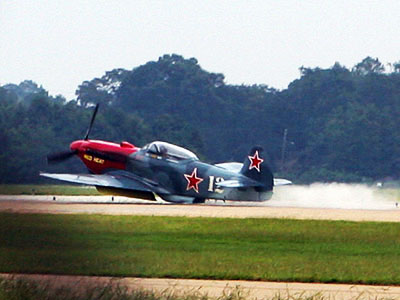
YAK-3 - $$5.95
The Yakovlev Yak-3 (Russian: Як-3) was a World War II Soviet fighter aircraft regarded as one of the best fighters of the war. It was one of the smallest and lightest major combat fighters fielded by any combatant during the war, and its high power-to-weight ratio gave it excellent performance.
Russian WWII YAK-3 Fighter
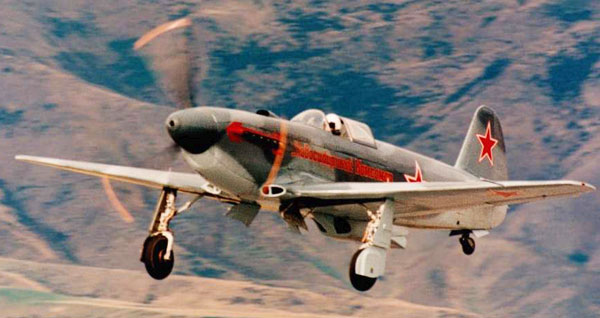
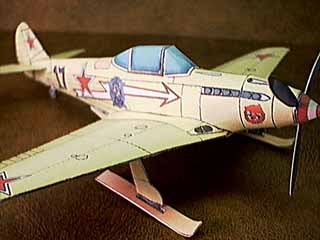
This is a 'fun' model that can even be mounted on skis that are included as an option. This is an important inclusion to our kit of WWII Top Ten fighters because so many of them were made and, interestingly, are being reproduced again for the world market. It's possibly the most agile monoplane in WWII-the basic essence of the YAK was robust simplicity.
One of the most successful series of single engine fighter aircraft produced by the Soviets during WWII came from the Yakovlev Design Bureau and these included the Yak-1, Yak-3, Yak-7, and Yak-9. These designations are a bit confusing since the designs were not produced in numerical order.
Yak-3
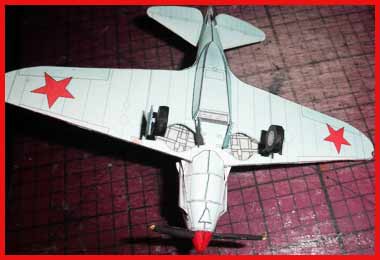 |
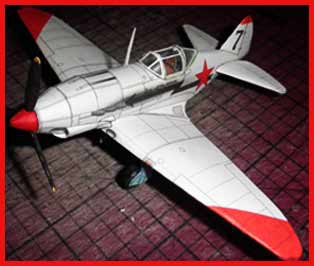 |
This Yakovlev Yak-3 is the model that won the FG Modeling Madness (FGMM) 2010 best in class prize. |
|
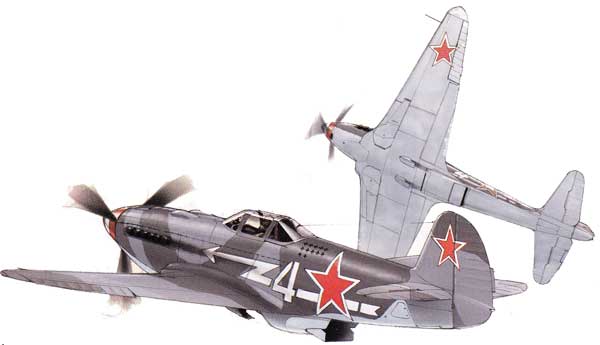
One of the most successful series of single engine fighter
aircraft produced by the Soviets during WWII came from the Yakovlev
Design Bureau and these included the Yak-1, Yak-3, Yak-7, and
Yak-9. These designations are a bit confusing since the designs
were not produced in numerical order.
The Yak-3 was developed alongside the Yak-9 but with a different mission since the type was originally designed to work in cooperation with the Soviet army at low altitude. It differed in a number of ways from the Yak-9 and had a smaller wingspan.
Essentially a lightweight clipped wing variant of the Yak-9,
Pilots report that the aircraft flew similar to the Spitfire
but with better initial climb. Praised for being light,
fast, and rugged, the Yak-3 was rated as "superior"
to the FW 190 and the Bf 109G which it was meeting on a daily
basis.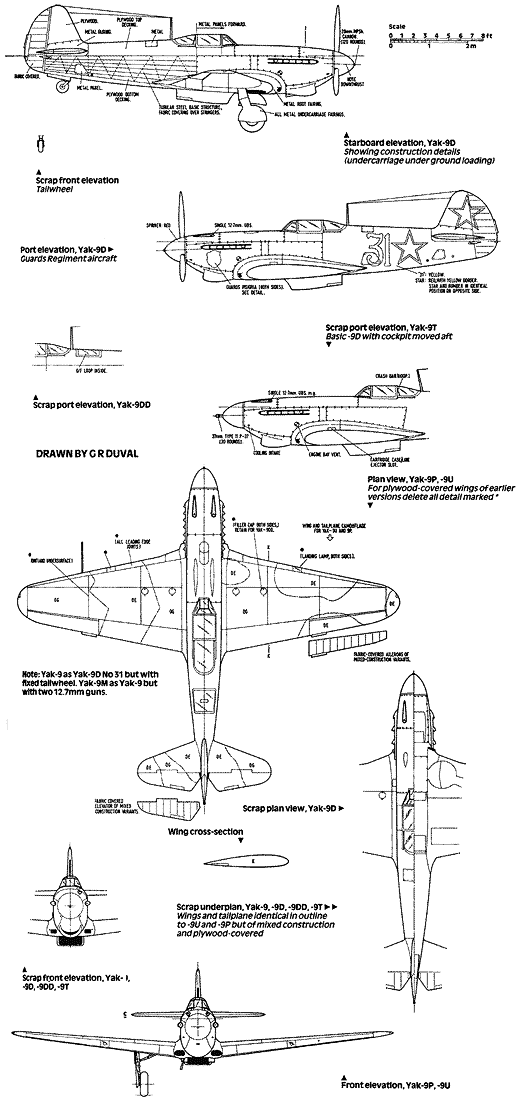
You'll always have better luck building models if you test the
fit before gluing the parts together permanently. The wing fairing's
incorporate an air scoop at the leading edge and after they're
installed, why not cut out the opening.
Possibly the most agile monoplane of World War I, the basic essence of Yak design was robust simplicity. There was an overriding requirement caused by the harsh Russian climate and a need to remain operational over vast snowbound areas, far from industrial facilities, with the minimum of servicing. Instruments and other delicate systems were restricted to absolute essentials such as rev-counters, pressure meters, and the coolant thermometer.
This is a 'fun' model that can even be mounted on skis that are included as an option. This was an important member of the Fiddlers Green WWII 'Special Merit' club. You'll enjoy making this colorful model..it's well worth being included in this series.
Soviet aircraft take their designation from the designer
rather than the manufacturer. In 925, Aleksandr S. Yakovlev began
to design gliders, but ten years later he embarked on a study
of fighters, and when in I 938 the Soviet government had an urgent
need in this field he quickly came up with the Ya-26 Krasavec
(beauty) prototype which flew in March 1939. This wood and tubular
steel fighter was typically Russian in having a huge engine in
a small airframe, with very limited armament.
Soviet pilots, often badly trained, found it difficult to fly at first, and many Yak-I production fighters crashed, Production was in full swing by the German invasion of 22 June 941, but by October I 941 production had to be transferred 1600km from Moscow to Kamensk-Uralskii, east of the Urals.
By the end of that year output had not only been restored but increased enormously, and eventually more Yaks (all types) were built than any other fighter in aviation history, accounting for 60% of all Soviet fighters built during 1941-45. In about 18 months the Yak was the subject of so much rapid development that the Yak-9 actually entered service in the winter of 1942.
Originally designated the 7D1, the Yak-9, while retaining its wooden skin, incorporated portions of light alloy structure which gave it a greater fuel capacity, This, together with very many detail improvements, enabled its pilots to meet the German Sf lO9Fs and Gs in the terrible battle of Stalingrad on roughly equal terms, In fact, the Yak's only problem was its relative lack of firepower.
In 1944, when the smaller Yak-3 dog fighter entered service, its performance was so impressive that the Luftwaffe command issued orders to its pilots that engagement with this fighter was to be avoided at all costs, In 1944, the Normandie-Niemen Group (a Soviet-based Free French squadron) scored a total of 273 kills against the Luftwaffe, all gained on Yak fighters given to the group by the Soviet Union; over one-third were attributable to Yak-3s. Later still, the remarkably durable Yak-9 was employed against its former allies in the I 950-S3 conflict in Korea.
The basic essence of Yak design was robust simplicity, an overriding requirement caused by the harsh Russian climate and a need to remain operational over vast snowbound areas, far from industrial facilities, with the minimum of servicing. Instruments and other delicate systems were restricted to absolute essentials such as rev-counters and pressure-meters, and the indispensable coolant thermometer. There were no gyroscopic indicators at first other than that showing turn and bank.
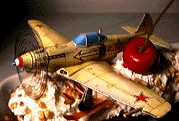 Fuel gauges were located
in the tops of the tanks in the wings, but this posed much less
of a problem than might at first be supposed. From mid-1942 the
Yak-IM had a very advanced cockpit canopy, reinforced at the
front and rear with thickened armored glass, which afforded
the pilot improved all-round vision, particularly to the rear,
which helped save many lives. The Yak-9 was the first single-seat
fighter in the world to have this invaluable facility, just one
of many that made this aircraft so well-loved by the men who
flew it.
Fuel gauges were located
in the tops of the tanks in the wings, but this posed much less
of a problem than might at first be supposed. From mid-1942 the
Yak-IM had a very advanced cockpit canopy, reinforced at the
front and rear with thickened armored glass, which afforded
the pilot improved all-round vision, particularly to the rear,
which helped save many lives. The Yak-9 was the first single-seat
fighter in the world to have this invaluable facility, just one
of many that made this aircraft so well-loved by the men who
flew it.
Aleksandr S. Yakovlev designed his innovative aeroplane with the pilot always in mind: another safety factor was a system by which the fuel tanks received the burnt exhaust gases purified through a filter as they gradually emptied, so that the omnipresent danger of an explosion during aerial combat was vastly reduced. And, although the aircraft in practice spent most of their life at low and medium altitudes, each had an oxygen mask on a hook at the cockpit's left side.
This often incorporated a radio telephone headset but, as wearing this restricted head movement, most pilots preferred to fly in silence and rely upon the good all-round vision. Many Yaks had no radio, Curiously, pilots also needed to unbuckle their seat-straps which, unlike those of Western aircraft, held the pilot's shoulders rigidly fixed. Stranger still, this tight harness design was never modified, not even in the Yak-3.
The Yak-9s and -3s did, however, embody many improvements, not least being that of firepower. A 20mm ShVAK rapid-fire cannon firing through the hub of the propeller was standard on most Yaks, with one or two heavy BS machine guns above. .A few Yak-9Ts and -9Ks had enormous anti-tank cannon, Some had a 45mm gun, but because of the recoil and tendency to jam, this was soon replaced with a 37mm cannon.
This installation was used to great effect during and after the Battle of Kursk, but it too demanded certain care in operation because the recoil reaction served to reduce airspeed. On at least one occasion a pilot turned this drawback into an advantage by firing the cannon to act as a brake on a too-short icy landing strip.
Although it closely resembled the Yak-9 in silhouette, the Yak-3 was a lighter, faster and an even more elegant aircraft. Weighing only 2670kg in full battle order, it had an astonishing rate of climb, held beautifully firm in tight turns, and generally performed with tremendous vivacity, British pilots who flew both machines compared it very favorably with the Spitfire.
Inevitably though, the early batches of this remarkable aircraft had their teething troubles, and perhaps the most disconcerting of these concerned the undercarriage retention gear. Having apparently hooked back into the retracted position, the undercarriage would often, when the pilot put on a sudden burst of speed. Drop down suddenly with a juddering thud.
But thanks to continued design efforts this and other faults were always quickly remedied. Yak-9s and -3s went on long after the end of World War II to be flown by a wide variety of air forces in many parts of the world. The Yak-9 trainer was produced in Poland in 1946. The Normandie-Niemen Group were permitted to retain their Yak-3s and took them back to France when hostilities ceased: one example is preserved in the Muse de l'Air at Le Bourget. Last of the wartime Yaks, the -9U, was retained in Germany and ironically, used for the 'buzzing' and harassment of Western aircraft during the Berlin Airlift, when the Russians attempted to isolate that city in 1948-49.
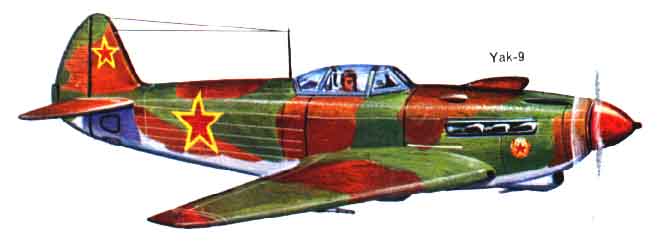
The Yak-9, itself produced in a number of variants, represented the culmination of a highly successful line of single-engine fighters and trainers from the Yakovlev design bureau whose combined production total was some 30,000.
It stemmed from the 1-26 prototype of 1938, which became the Yak-l in production in 1940, via the Yak-7, and the machines which acted as Yak-9 prototypes were originally designated Yak-7D1, signifying that they were designed as long-range fighters.
They appeared in the first half of 1942, differing from the standard Yak-7B fighter chiefly in making greater use of light alloys. Production began in autumn 1942, and the Yak-9 was in operational service by the turn of the year in the Stalingrad fighting. In 1943 the Yak-9 began to be used as an anti-tank aircraft, being modified for this purpose as the Yak-9T to carry a 37mm cannon or a lighter weapon in the forward part of the fuselage.
This was followed in 1944 by the Yak-9K, mounting a 45mm cannon that fired through the propeller shaft. The Yak-9B was a fighter-bomber version equipped to carry a 9921b (450kg) bomb internally, and in 1943-44 the Yak-9D and Yak-9D emerged as variants with their range further increased to provide fighter cover for advancing troops and for bombing raids over enemy-held territory. One squadron of these. flying from southern Italy after the Italian armistice, provided support for the partisan forces in Yugoslavia, and other Yak-9 variants served with Polish and French units (including the celebrated Norrnandie-Niemen group) fighting in the USSR. The last major version to serve during the war was the all metal Yak-9U, whose prototype flew in January 1944.
This became operational during, the second half of that year and was characterized chiefly by further aerodynamic refinements and the adoption of the new l,600 hp VK-107A engine which raised the top speed to 435mph (700kmh). The Yak-9U climbed from sea level to l8,400ft (5,000m) in nearly 30 seconds less than the Messerschmitt Bf 109G. The final Yak-9 variant (known briefly as the Yak-Il) was the Yak-9P of 1945. This saw little service in World War 2. but was a standard postwar fighter and fighter-bomber with Soviet air forces, including the North Korean Air Force during 1950-53.
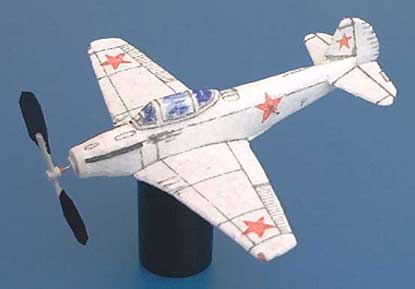 Paul Needham sends in this photo of his flying YAK-9 saying ....it flies indoor on rubber and currently does around 40 seconds. It flies very slowly in wide left hand turns and I think when I have found the right length of rubber and number of turns it should fly for over a minute. Just copied your markings using a felt tip pen ! Cut the stars out and used them as a stencil. |
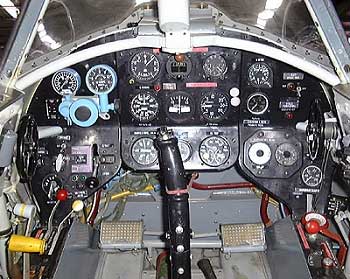 |
Yakovlev Yak-3 Cockpit. |
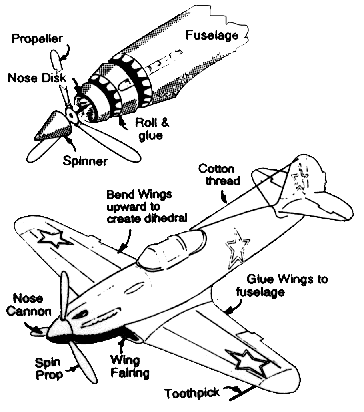
Specifications for the Yakovlev Yak-3
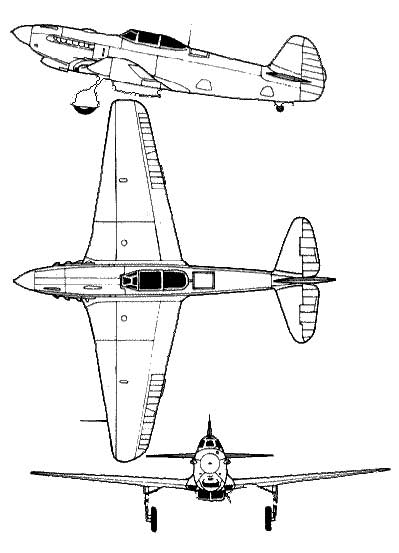 |
Length: 27 ft 10 in |
 |
||
| A: Despite problems associated with cooling and supercharging in some versions, the Yak-3's VK 107 engine was still well suited to operating in Russia's appalling winters. | B: Yak 3s had a variety of armament. usually consisting of one 20 mm ShVAK cannon with 120 rounds mounted in the engine and one or two UBS 12.7 mm (.50 caliber) machine guns with 150 rounds above it. | C: The bubble canopy design replaced the razorback style canopy of the Yak-1 and Yak-7. |
| D: Early Yak 3s had a 1/16 inch plywood fuselage skin. The final wartime variant, with a VK-107A, had a skin of Elektron (magnesium alloy). | E: The nose-mounted cannon fired through the spinner. Some Yak 3s had a ShA-20MM cannon with 110 rounds. | F: The last Yak 3s had a metal tail construction, replacing the wood of earlier versions. |
